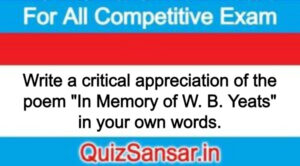
Write a critical appreciation of the poem “In Memory of W. B. Yeats” in your own words.
Write a critical appreciation of the poem “In Memory of W. B. Yeats” in your own words.
Or
Write in detail about the abiding popularity of the poem “In Memory of W. B. Yeats.”
Or
Write in brief about the theme and structure of the poem “In Memory of V. B. Yeats.”
Ans.
“In Memory of W. B. Yeats” is one of the most famous occasional poem of W. H. Auden. It is an elegy but here Auden departs from the conventions that are followed by elegiac poets. Instead of idealizing Yeats as a poet or sentimentalizing over his fate, Auden makes some general reflections on the art of the poet and the place of poetry in the general flux of events. These events, in tact, constitute human history. There is no denying the fact in “In Memory of W. B. Yeats” instead of finding an overflow of powerful feelings and sentiments we find deliberate statements. Speaking about his elegies on Freud and Yeats, in an interview published in the New York Quarterly in 1970, Auden said, “These elegies of mine are not poems of grief. Freud I never met, and Yeats I met only casually and did not particularly like him. Sometimes a man stands for certain things, which is quite different from what one feels in personal grief.”
“In Memory of W. B. Yeats” is divided into three movements in which there is not much organic relationship and each stanza has its own independent strain of thought. But it would be incorrect to say that there is no connection whatsoever in the three somewhat independent looking parts. The three movements are joined by a strain of thought which combines the three parts of the poem.
The first of the elegy’s three movements describe the time of the death of Yeats. It must he kept in mind that Auden had recently migrated to America when he heard the news of the death of Yeats. He had landed in New York only two days before the death of Yeats on 26 January, 1939, the weather of New York was worst-it was “the dead of winter”, which Auden transferred to the weather of the south of France where Yeats died:
He disappeared into the dead of winter,
The brooke were frozen, the airport almost deserted,
And snow disfigured the public status;
The mercury sunk into the mouth of the dying day.
The use of the word ‘disappeared’ in the opening line of the poem is extremely significant. In simple language ‘disappeared means died. But it is more than that. Auden had come to America only very recently, hence he must have found himself ‘disappeared’ in the mass of the life of New York. Moreover, there is another strain of thought too here. Yeats himself used ‘disappeared’ in this sense in A Vision: “At death the hint of Auden is unmistakable.” Yeats’ creative energy is decreasing and this energy has been transferred to the living persons-“he became his admirers’-who read and enjoy his poems.
The first movement of the poem originally ended with the following
retrain:
O all the instruments agree
The day of his death was a dark cold day.
But Auden was not satisfied with the First line, it smacked too much of Yeats. So he changed it to a more matter of fact statement thus:
What instruments we have agree
The day of his death was a dark cold day.
Edward Callan, commenting upon this change observes: “The change may seem slight, but anyone familiar with his poetry will recognize the voice of Yeats in the line ‘O all the instruments agree… while those familiar with Auden’s work will recognize to more matter of fact, what instruments we have agree’ as authentically his one.” It is these slight revisions which prove that Auden wanted to move out of the enchantment of Yeats.
Section 2 is the shortest unit in the poem and what is more significant is that it was added by Auden after the first publication of the poem. Here Auden addresses Yeats on shared consciousness which passes from Husk to Spirit; Husk and Passionate Body are said to disappear.” Hence it is an unconscious echo of the manner of the person whose death he commemorates in this elegy.
Despite the fact that the airport’ is almost deserted’ and the public statues by snow disfigured’ they remain permanent. This permanence is matched by the evergreen forests:
So the man-made world of airports and public statues and the natural world of evergreen forests and peasant rivers, both remain immune to the death of Yeats. Almost the same idea of indifference is mentioned by Auden in “Musee des Beaux Arts” where we are told that the martyrdom of the highest, order passes unnoticed. This imagery of “In Memory of W. B. Yeats” is followed by the image of the city of the mind in dissolution:
The provinces of his body revolted,
The squares of his mind were empty,
Silence invaded the suburbs,
The current of his feeling failed: he became his admirers,
Weaknesses:
You were silly, like us; your gift survived it all;
The parish of rich women, physical decay,
Yourself…
In this part Auden enumerates personal weaknesses of Yeats. “Physical decay is obviously reference to Yeats’ desire to undergo a Steinach operation to rejuvenate himself and regain his lost virility. (In those days the Steinach surgery was undergone to increase physical and mental virility.) The parish of rich women refers to many women with whom Yeats was in close intimacy. These include his wife, Lady Gregory. Annie Horniman, Maud Gonne and Florence Farr.
This second section also tells us about the limitations of art:
Now Ireland has her madness and her weather still,
For poetry makes nothing happen:
The phrase “for poetry makes nothing happen” echoes “September1. 1939” where Auden says: “All I have a voice,” Auden continues and says poetry “survives into the valley of its making” In its original version Auden had written “poetry survives into the valley of its singing.” Auden limits the echo of the words of the poet. Why does the poet say that poetry ‘flows from south,” This key symbolic phrase has been explained by Callan thus: In Jung’s orientation of the psyche of the ‘thinking type’ (personified by Malin in Auden’s The Age of Anxiety, the north is associated with isolated, even margin intellect and the South with feeling submerged in unconsciousness. The achievement of a ‘whole’ or ‘healed’ personality requires that these opposing faculties move towards reconciliation. Therefore to say poetry ‘flows on South’ is to represent it as an agent of emotional healing, capable of restoring harmony between intellect and feeling.”
The thought of the second stanza is the spring board of thought for the next movement. The ideas is expressed by Auden thus:
In the desert of the heart
Let the healing fountain start.
This section also refers to the disorder in the body politic of Europe:
In the nightmare of the dark
All the dogs of Europe bark,
And the living nations wait,
Each sequestered in its hate.
Thus Auden contrasts the ideal order which the poet has the power to command and the disorder in the body politic of Europe. Only the poet has the capacity to start a ‘healing fountain’ in the desert of the heart. Only a poet can provide a glimpse of the ideal thereby imposing order on chaotic conditions of Europe.
-
Write the critical appreciation of the poem No. 12 entitled Far Below Flowed.
-
Write the critical appreciation of the poem No. 11 entitled Leave this Chanting.






